The Best Flowering Vines to Grow in Alabama
Native flowering vines are beautiful plants that provide year-round interest. They also offer great benefits such as attracting butterflies and hummingbirds, giving food for wildlife, and adding beauty to your garden. Native plants also benefit from environmental protection, increased biodiversity, and improved soil quality. There are several native flowering vines to choose from, each offering unique characteristics. Planting native vines help reverse the decline of native plant species in Alabama.
There are three main native flowering vines: climbing, twining, and trailing. Each offers its advantages and disadvantages.
Climbing vines tend to be easier to care for because they don’t require support structures. They also increase and are often planted near trees and shrubs where they can climb over them.
Twining vines usually grow into tight spirals around other plants. This makes them ideal for growing next to fences or walls. Their long stems allow them to reach higher than most other vines.
Trailing vines grow along the ground, spreading out across large areas. These vines are perfect for growing in pots or hanging baskets. They are also good at hiding unsightly objects and keeping weeds away.
With relatively mild winters, significantly below the Mason Dixon Line, Alabama is an ideal environment for non-native species to thrive. Unfortunately, some of these exotic invaders are becoming increasingly problematic and threaten the native flora and fauna of the entire region.
Below are ten types of native flowering vines recommended to grow in Alabama:
Bignonia Capreolata (Cross Vine)
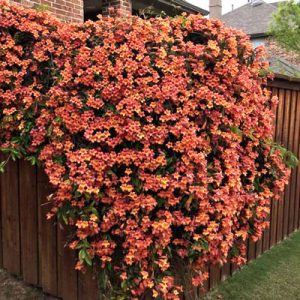
Bignonia Capreolata cross vine is a fast grower, self-clinging, woody vine with abundant trumpet-shaped, brightly colored blooms. Regarded as one of the most floriferous of the vining plants, it is virtually covered in large clusters of two to five colorful blossoms in the mid-season with intermittent summer blooms.
Lasting for about four months, the blooms offer a spectacular floral display. They are visited by hummingbirds who never miss an opportunity to feed on the nectar. The flowers are preceded by greenish pods, which mature in the late season and persist until autumn. The foliage of opposite shiny dark green leaves is evergreen in mild climate areas but changes color to purple in cooler regions before falling to the ground.
It climbs and scrambles over everything in its way, using tendril-like shoots with sticky tips to attach itself to surfaces. Be careful not to let it spread too far because it can grow into trees and buildings.
- Easy to care for, this Trumpet Vine grows into an attractive shrub reaching heights of 10-20 feet (3-6 meters) with arching branches and glossy green leaves. Prune back spent growth periodically to maintain shape and keep plants healthy. Water regularly during dry spells.
- Thrives organically rich, well-drained soil, full sun or part sun. Tolerates, however, a wide variety of soil types. Best flower production is achieved in full sun. Tolerance of coastal environments. Drought tolerant once planted.
- Insects and diseases don’t pose any major threats. Deer resistant.
- For good groundcover, choose plants that grow well in poor soil conditions, such as forsythia.
- This plant grows from seedlings. You can prune it when it starts growing multiple shoots at once. To encourage more flowers, tie the stems together.
- Native to Alabama
Campsis radicans (Trumpet Vine)
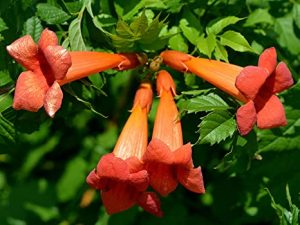
A vigorous North American species, Trumpet Vine, is a self-climbing shrub with particularly showy trumpet-like flower heads, 3 inches (7cm) long. They appear throughout summer and provide a long-lived and spectacular floral display. These beautiful tubular blossoms are borne in clusters at branch tips and give off a strong scent.
Birds such as Hummingbirds love to visit them. The blooms follow by attractive pod-like seedpods produced by the plant. The foliage is evergreen and glossy. Trumpet Vine is nevertheless useful for erosion prevention by climbing or creeping along walls and fences by means of aerial roots, which may cause structural damage. Please ensure you get your hands on this one because it is very invasive.
- Blooms throughout early spring until late fall, this extremely fragrant Trumpet Vine tolerates heat, cold, and drought.
- Thrives in lean soil conditions and tolerates some drought, but best flower production is achieved when grown in full sun.
- Hardy and easy to care for, this trumpet vine multiplies and can reach heights of 6 meters (20 feet) or more. It suckers roots from underground runners and freely spreads by seed.
- There are no significant pest or disease problems.
- Excellent choice fortrellises, walls, and fences or arbors.
- This vine blooms in midwinter and should be pruned after flowering. Remove any dead or dying wood, leaving two to three bud clusters per shoot. Shorten the length of each cluster, so they grow into one another. Prune out any weak or spindly shoots.
- Native from Ohio and northern New Jersey, eastern Texas, and Dakota.
Mikania Scandens (Climbing Hempvine)
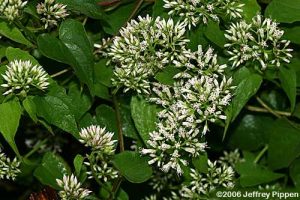
The Mikania scandens, commonly known as the Common Milkweed, is a perennial herbaceous plant native to the Eastern and Central US. It has been introduced to many parts of the world, including Europe, Australia, Africa, Asia, and North America. In the US, it is now found throughout the southern states. It is a member of the aster family, Asteraceae.
Its common names include milkweed, hempvine, and kudzu vine. It is a climbing plant that produces yellow daisy-like flowers in the summer. The plant’s name comes from the milky sap that oozes from the stem when cut. It is a weed in many places because it invades open fields and pastures. However, it does have uses as a food source for birds and insects.
It is an excellent choice for a butterfly garden and is recommended for natural landscaping and restoration projects.
- It grows up to 10 feet tall (3 meters) and weighs anywhere from 100 lbs. to 400.
- thrives in alkaline soil and can withstand water-logging.
- There are no major insect or disease issues.
- grown by seed.
- Native to the Eastern and Central US, Mexico, Central America, and the Caribbean.
Lonicera sempervirens
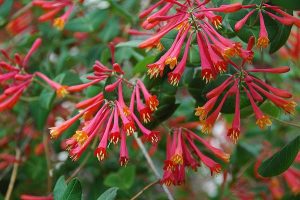
Trumpet honeysuckles are vigorous climbers, increasing to about 10 feet tall and wide. Their blooms are trumpet-shaped, opening to reveal bright yellow throats, followed by tiny, bright red berries. These fruits are eaten by wildlife, including hummingbird species. The plants are also used commercially for honey production. In addition, the shrub can grow into dense thickets, providing habitat for native animals such as rabbits, raccoons, snakes, and bats.
- They are often used as ground cover and can be trained over trellises or arbors.
- Insects and diseases are rarely a problem.
- Double varieties are usually more vigorous than single varieties.
- Single varieties tend to bloom earlier than double varieties.
- Some honeysuckles have been bred specifically for use as berry producers.
- Most honeysuckles are propagated by seeds. Seeds germinate.
Vitis rotundifolia (Muscadine)
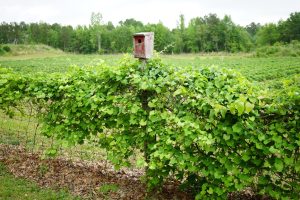
Vigorous and vigorous growing, Muscadines are large, deciduous vines valued for their delicious, juicy fruit. Their long-spreading, alternate branches are covered with rough, coarsely serrated, leathery-looking, dark green foliage, about 4 inches wide. In late autumn, the foliage turns golden-yellow.
Muscat grapes come in two varieties — sweet and sour. Sweet Muscadines are grown primarily for eating out of hand; Sour Muscadines are made into wine. Both types are popular in the southeast U.S. and are often called “scuppernongs.” Muscat grapes are grown commercially in the south; they are also called “muscadines” because they were initially cultivated around the town of Muscadet in France.
- It can reach between 8–80 feet (2.4–24 meters), and its width varies depending on the number of supports it gets.
- Fruits thrive in neutral to slightly acidic, moisture-retentive, well-drained soil. It prefers deep, sandy loams. Fruit production improves under full sunlight.
- Muscadine grapes have a high level of tolerance to pests and disease (resistant to Pierce’s Disease and the insect Phylloxerra).
- Propagate by layered or hardwood cuttings.
- Prune muscadine grapes when they’re dormant.
- Native to the southeastern United States and South Central states.
Black-Eyed Susan Vine
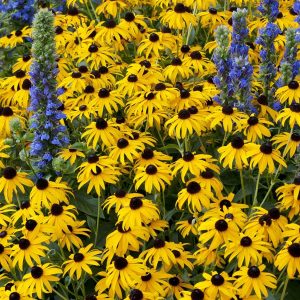
This fast-growing annual vine is often confused with Morning Glory because both vines are grown for their flowers. Black-eyed Susans are subtropical vines that prefer full sun and well-drained soil.
They flower best in warm climates like Florida, California, Texas, Louisiana, and Hawaii. This vine produces large clusters of small, single flowers that turn into grape-sized fruits called berries. These berries ripen from late spring to early autumn.
Climbing Hydrangea (Hydrangea anomala)
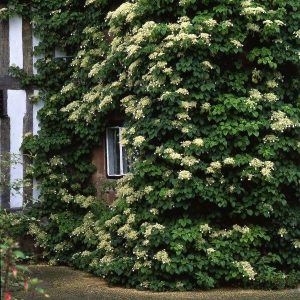
Climbing hydrangeas are one of the easiest flowering shrubs to grow. They bloom abundantly throughout the season producing large clusters of starry white or pinkish-white blossoms. These easy-care shrubs are great for adding color to shady areas where you don’t want to spend much energy tending to your garden.
The best way to enjoy climbing hydrangeas is to plant several varieties together. This allows you to choose different heights and colors for each planting.
You’ll find that some types produce smaller, single-flowered branches while others have larger, multi-branched specimens. Some come in reds, oranges, yellows, pinks, purples, blues, whites, and greens.
Jasmine Vines
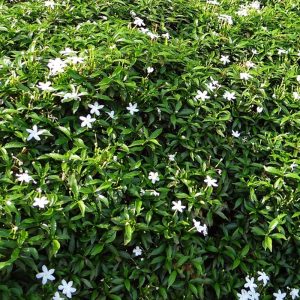
While most people think of jasmine as a fragrant shrub, it grows into a climbing plant. This makes it perfect for growing indoors, where it needs less sunlight. Most varieties of jasmine do well in pots, hanging baskets, window boxes, and even hanging planters.
They love being planted near windows because they enjoy lots of indirect light.
The flowers of some jasmine plants open during the day, while others bloom in the evening. There are many types of jasmine, including single, double, and triple flowers.
Some have white flowers, while others have yellow, orange, red, or pink blossoms. In addition, some produce clusters of tiny buds called catkins. These are usually greenish-yellow or brown.
American Wisteria (Wisteria frutescens)
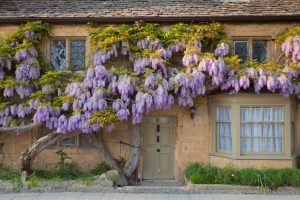
This hardy perennial vine grows up to 15 feet tall and spreads quickly. Its long, arching branches are covered in small clusters of white blooms that look like miniature peonies. This species prefers well-drained soil and full sun. It does fine even without fertilizer. But you want to fertilize it every few weeks during the growing season to keep it healthy and vigorous. When planted against a wall, it will grow into the structure and support climbing plants.
The seeds germinate quickly and produce seedlings within three months. They are ready to transplant in late winter or early spring. You can divide the roots in the fall, too. Plant them 12 inches apart in rows 30 inches apart.
Rosa Setigera (Prairie Rose )
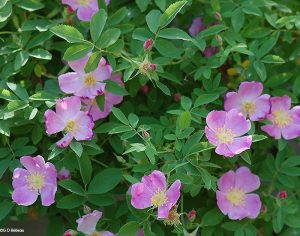
Rosa setigera (Prairie Rose ) is a deciduous tree or shrubby plant with long climbing stems and narrow, leathery, evergreen foliage. Its glossy, dark green compound leafs are studded with sharp spines.
In late spring to mid-summer, a profuse amount of 5 petalled, light pink to pinkish-red blooms, 2 inches wide, are displayed on the tree. These are adorned with a showier bouquet of golden stamen and tend to fade to whitish as they age, creating an attractive bi-colored effect. Prairie Rose is an excellent addition to wildlife habitats and is helpful in locations where it can freely grow or scramble.
- Grows up to 5-7 feet high (150-200cm) and spreads out to about 10 feet wide (3 m). Prairie rose can reproduce either by seeds or by suckers off the stem; it also produces flowers throughout the year, unlike most roses that bloom only once per season.
- Best grown under full sunlight.
- A perfect choice for cottage gardens, wildflower meadows, native plants, or informal hedging.
- This particular variety of Rosa has greater natural disease resistance than most hybrids. Look out for aphids, beetle, borer, scales, thrips, leafhopper, and webbing mite infestations.
- Attracting pollinators.
- Prune your trees in late fall to early spring.
- Propagation is done through cutting and seeding.
- Native to eastern and central North America.
Confederate Jasmine (Trachelospermum jasminoides)
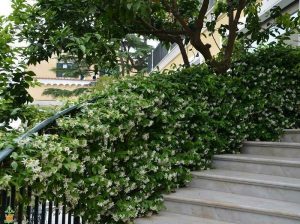
Jasmine is one of the most popular flowering plants around the world. There are over 300 species of jasmine, and they’re found all across the globe. These plants produce beautiful white blooms throughout the summer months, but they’re often confused with each other. Here we’ll look at one of the most common varieties, Confederate jasmine.
This variety grows best in USDA zone 8 and warmer. It requires total sun exposure and regular watering during dry spells. The soil should be well-drained and rich in nutrients. In colder areas, it needs some protection from temperatures below freezing. If you live in zone 7, you could try growing it outdoors, but keep it protected from frost.
The Confederate jasmine is easily propagated via seed, cuttings, or division. Seeds germinate quickly and grow into healthy young plants within about ten days. You can start seeds indoors four weeks before planting outside. Cuttings take about two weeks to root. The division takes several months, depending on how long you want to wait.


